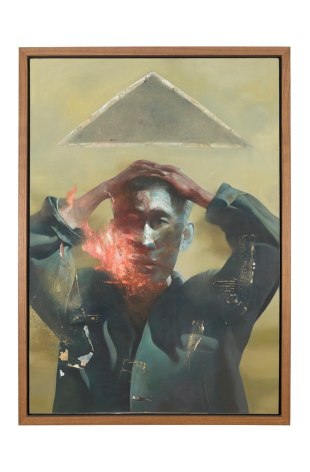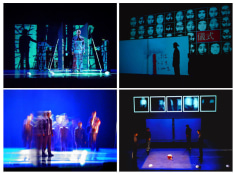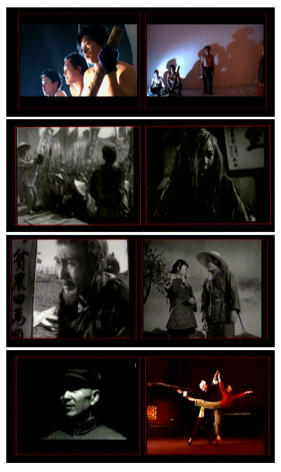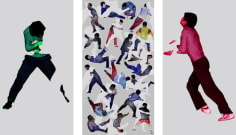Chambers Fine Art New York is pleased to announce the opening on October 4th of Dilemma: Three Way Fork in the Road by Wang Jianwei. This will be the artist’s second solo exhibition in New York, the first having been Flying Bird is Motionless held at Chambers Fine Art in 2005. Born in Sichuan Province, China in 1958, Wang Jianwei was trained as a painter at the Zhejiang Academy of Fine Arts (new China Academy of Fine Arts) in Hangzhou. The technical virtuosity and compelling drama of these paintings would have guaranteed him a prominent position as a painter had he chosen to pursue this path but instead he chose to diversify, investigating video, film and theater in different combinations.
Wang Jianwei’s range of interests embraces both the mundane and the historical or mythological. Foremost in the former category is the celebrated two-hour documentary Living Elsewhere (1999-2000) which documented with a sensitivity worthy of the Italian Neo-Realists the plight of peasants occupying an abandoned housing project in Sichuan Province. At the other extreme are works such as Ceremony 1 and Ceremony II which respectively referenced two extreme modes of stylized expression, films of post 1949 China during the height of Communist fervor and stories from the Tang Dynasty. Past and present, the visible and invisible coexist in Wang Jianwei’s oeuvre, resulting in a critical position of peculiar intensity.
This direction in his work has become more pronounced in recent years, notably in Flying Bird is Motionless and one of his latest video works, Symptom. Anselm Franke has described the latter as “a monumental tableau vivant presenting what could be China itself, as a haunted space in which a series of asynchronous spaces coexist (and collide) on one stage. Formally, these works come also close to opera, but what makes the scenery so strong is a sense that what really comes into existence here is the paradoxical presence of history in China itself, that is to say its complete disappearance between the smokescreen of phantom objectivity, and its hyper-presence on the horizon beyond.”
In Dilemma: Three Way Fork in the Road, Wang Jianwei intensifies the visual and temporal dissonance that has characterized his recent videos and mixed-media theatrical experiments. With references to the Peking Opera, two armed figures circle each other warily as, oblivious to their presence, actors in period uniforms and contemporary dress enter the theatrical arena. In increasing numbers they consume a variety of foods until they collapse in a heap. As Wang Jianwei has remarked: “I aim to deal with the representation of the visible and the invisible in the image and at the same time, two kinds of time, past and present. A full understanding of the complicated social and cultural issues facing Chinese society in the past 100 years, culminating perhaps today in the mad rush to modernize, cannot be achieved by limiting one’s focus to the past or the present. Antiquarianism does not provide the answers any more than does immersion in today’s technical achievements.”
The video will be accompanied by two groups of photographs of the same performance, one related to the video and the other shot dramatically from above.
*A catalog will be available.
前波画廊将于10月4日起举办汪建伟的个展《三岔口》。此展览是继2005年的《飞鸟不动》之后,汪建伟在纽约创作的第二次个人展览。汪建伟于1958年出生于四川,最初在杭州美术学院(现中国美术学院)学习绘画。他在那段时间内所创作的油画作品在技法和视觉效果上都具有原创性和强烈的感染力,也确定了他在画坛的地位。但他并没有停留在油画这条艺术道路上,反而选择了更具多样性的创作方式,运用和组合录影,电影,舞台表演等媒体。
汪建伟的兴趣广泛,从日常生活到历史和神话传说。前者的代表作是著名的长达2小时的纪录片《生活在别处》(1999-2000年)。他在这件作品中记录了四川农民居住在被废弃的住宅建筑中的艰苦生活,其敏感程度可与意大利新现实主义艺术家媲美。与这件作品几乎皆然相反的作品,比如《仪式1》和《仪式2》等,则分别以共产主义狂热和唐代故事传奇等几乎程式化的表现方式作为创作参照。过去与现在,看得见的与看不见的在汪建伟的创作中共存,将其作品置于一个具有特殊激烈性的关键位置上。
这个创作趋势在他近年的作品中特别突出,比如《飞鸟不动》和最新的录影作品《症候》。Anselm Franke评价后者为“一个纪念碑式的生动场面,表现了中国本身作为一个萦绕于怀的空间可能会成为什么样式——一系列非同步空间同时在一个舞台上并存(并相互抵触)。从形式上看,这些作品同戏剧有着密切的关系,但使得舞台布景变得如此有力的,是这里实际呈现出来的一种感觉,即中国本身自相矛盾的历史呈现,也就是它完全消失在虚幻客观性的迷雾背后,同时又超然地呈现在地平线的那一端。”
在《三岔口》中,汪建伟进一步强化视觉和时间的不同步性,这也是他最近录影和实验性多媒体舞台作品的特征。这件作品受京剧的影响,两位手持武器的人物谨慎地相互绕圈。同时,其他人物无视他们的存在,身着古装或现代服装进入舞台。他们一个接着一个走上舞台,吞食各种食物,直到最后倒在一起。汪建伟解释说:“我的目标是在图像中同时表现看得见与看不见,以及两种时间——过去与现在。要真正理解中国社会在过去的一百多年里所面临的社会和文化问题——升华为今天就是现代化狂热——我们不能只看到过去或只了解现在。复古主义不是答案,就像沉醉于当今的技术发展不能解决问题一样。”
此次展览不仅将展出《三岔口》这件录影作品,还将陈列两组摄影。它们都表现同样一场表演,一组与录影相关联,另一组则从空中这一超出寻常的角度所拍摄。
*提供展览目录





